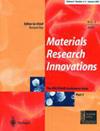Eu3+掺杂对PbO/PMMA纳米复合材料三阶非线性光学性能的影响
Q2 Engineering
引用次数: 1
摘要
采用化学沉淀法合成了PbO/PMMA、3和6 mol%离子掺杂的PbO/PMMA纳米复合材料。对于所有的纳米复合材料,XRD图证实了PbO的正交结构。SEM图显示了PMMA中PbO纳米颗粒的形貌。FTIR证实了Eu3+掺杂PbO纳米颗粒在PMMA中形成纳米复合材料。当将PMMA中Eu3+掺杂的PbO纳米颗粒与本体PbO进行比较时,紫外-可见光学吸收发现在吸收带上出现蓝移。光学带隙能量随Eu3+掺杂浓度的增加而降低,并与红移现象有关。PL光谱显示了一个与合成缺陷引起的蓝色发射相关的发射峰。对6 mol% Eu3+离子掺杂的PbO/PMMA纳米复合材料,采用z -扫描技术测定了非线性光导率(χ(3))、非线性光折射率(n2)和非线性光吸收系数(β)等三阶非线性光学参数,其值分别为4.468 × 10−6 esu、1.257 × 10−7cm2/W和9.837 × 10−3 cm/W。目前Eu3+离子掺杂的PbO/PMMA纳米复合材料具有很强的非线性特性,在三阶非线性光学器件中具有广阔的应用前景。本文章由计算机程序翻译,如有差异,请以英文原文为准。
Influence of Eu3+ dopant on the third order nonlinear optical properties of PbO/PMMA nanocomposites
ABSTRACT PbO/PMMA, 3 and 6 mol% ion-doped PbO/PMMA nanocomposites were synthesised using an easy chemical precipitation method. For all of the nanocomposites, the XRD pattern confirms the orthorhombic structure of PbO. The morphology of PbO nanoparticles in PMMA is revealed by the SEM graph. The formation of nanocomposites containing Eu3+ doped PbO nanoparticles in PMMA is confirmed by FTIR. When Eu3+ doped PbO nanoparticles in PMMA are compared to bulk PbO, UV–Vis optical absorption findings demonstrate a blue shift on the absorption band. The optical band gap energy decreases with increasing Eu3+ dopant concentration and is related to red-shifted phenomena. The PL spectra reveal an emission peak associated with blue emission caused by a synthesis defect. For 6 mol% Eu3+ ion doped PbO/PMMA nanocomposites, third-order nonlinear optical parameters such as nonlinear optical susceptibility (χ(3)), nonlinear optical refractive index (n2), and nonlinear optical absorption coefficient (β) are determined by Z-scan technique, and the values are found to be 4.468 × 10−6 esu, 1.257 × 10−7cm2/W, and 9.837 × 10−3 cm/W, respectively. The strong nonlinearity in the current Eu3+ ion-doped PbO/PMMA nanocomposites empowers its promising applications in third-order nonlinear optical devices.
求助全文
通过发布文献求助,成功后即可免费获取论文全文。
去求助
来源期刊

Materials Research Innovations
工程技术-材料科学:综合
CiteScore
5.20
自引率
0.00%
发文量
38
审稿时长
2.8 months
期刊介绍:
Materials Research Innovations covers all areas of materials research with a particular interest in synthesis, processing, and properties from the nanoscale to the microscale to the bulk. Coverage includes all classes of material – ceramics, metals, and polymers; semiconductors and other functional materials; organic and inorganic materials – alone or in combination as composites. Innovation in composition and processing to impart special properties to bulk materials and coatings, and for innovative applications in technology, represents a strong focus. The journal attempts to balance enduring themes of science and engineering with the innovation provided by such areas of research activity.
 求助内容:
求助内容: 应助结果提醒方式:
应助结果提醒方式:


